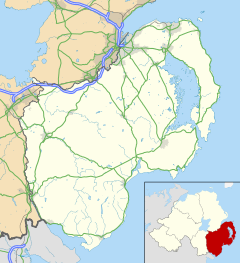Groomsport
Groomsport
|
|
|---|---|
 Groomsport harbour, March 2008 |
|
| Groomsport shown within County Down | |
| Population | 3,005 (2011 Census) |
| District | |
| County | |
| Country | Northern Ireland |
| Sovereign state | United Kingdom |
| Postcode district | BT |
| Dialling code | 028 |
| EU Parliament | Northern Ireland |
| UK Parliament | |
| Website | www.groomsport.info |
Groomsport (from Irish Port an Ghiolla Ghruama, meaning 'port of the gloomy servant') is a village and townland two miles north east of Bangor in County Down, Northern Ireland. It is on the south shore of Belfast Lough and on the north coast of the Ards Peninsula. Groomsport has a population of 3,005 people according to the 2011 Census,. It is part of the North Down Borough Council region.
Groomsport is a dormitory seaside and holiday village. Originally it was a small fishing village with the focus of development being the harbour and Main Street. Groomsport has developed as a centre for water and shore-based recreation with improved facilities for activities such as sailing and power boating. The Cockle Island Boat Club has its home here in the boat house on the pier.
The village developed beside the natural sheltered harbour, between the shore, Ballymacormick Point and the rocky outcrop known as Cockle Island. The harbour is reputed to be of Viking origin and the beginnings of the small settlement can be traced to the 9th or 10th century. Groomsport remained a fishing village through the Victorian and Edwardian periods until the 1920s. Groomsport still retains the identity and character of a small harbour village with its pier and sheltered anchorage together with its historic street pattern.
The village and townland derives its name from the Irish Port an Ghiolla Ghruama. This has historically been anglicised or half-anglicised as Portgillegroome, Gillgroomsport and Gilgroomsport. By the 17th century, before Donaghadee became the main port for embarkation for Scotland, Groomsport’s harbour was significant enough to have its own Customs House. Indeed, Groomsport narrowly missed out on New World fame when the ship Eagle Wing set out from the port, with 140 men, women and children, to attempt an early trip to North America in 1636 only to be defeated by bad weather after eight weeks at sea.
...
Wikipedia

